Nature & Conservation
The Burren National Park is located in the southeastern corner of the Burren and is approximately 1500 hectares in size. It contains examples of all the major habitats within the Burren: Limestone Pavement, Calcareous Grassland, Hazel scrub, Ash/Hazel Woodland, Turloughs, Lakes, Petrifying Springs, Cliffs and Fen.
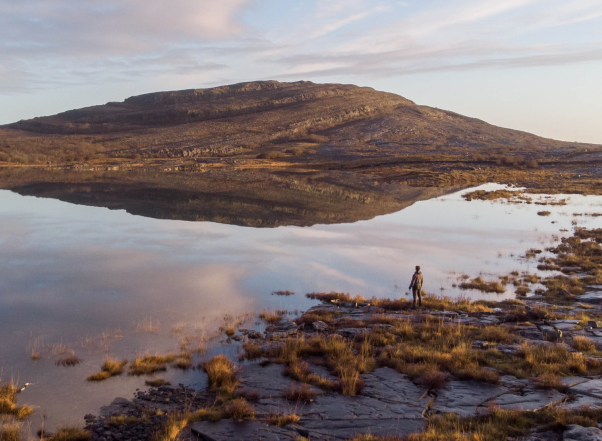
above:Karst Landscape of the Burren
The word “Burren” comes from an Irish word “Boíreann” meaning a rocky place. This is an extremely appropriate name when you consider the lack of soil cover and the extent of exposed Limestone Pavement. However, it has been referred to in the past as “Fertile rock” due to the mixture of nutrient rich herb and floral species.
Arctic-alpine plants live side by side with Mediterranean plants, calcicole (lime-loving) and calcifuge (acid-loving) plants grow adjacent to one another, and woodland plants grow out in the open with not a tree nearby to provide shade from the sun. You will also find certain species which, although rare elsewhere, are abundant in the Burren. All of these plants survive in a land that appears to be composed entirely of rock.

Thank you for helping us protect nature in the Burren. When you enjoy responsible outdoor recreation here, you help us preserve the unique creatures and habitats of the Burren landscape.
Please follow our protect nature tips below and remember to Leave no Trace of your visit:
Geology
The Burren is underlain by limestones of the Lower Carboniferous (Visean) period. The limestone formed as sediments in a tropical sea which covered most of Ireland approximately 350 million years ago. These sediments were compressed into horizontal strata and contain fossil corals, sea urchins, sea-lilies (crinnoids) and ammonites. The limestones within the park belong to the Asbian stage of the Burren formation of which two members are present:
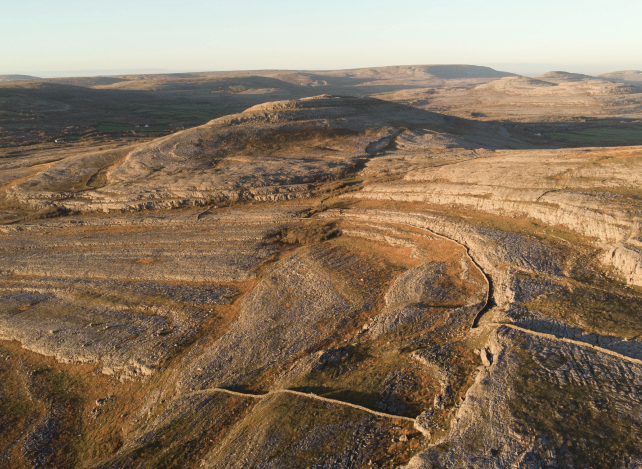
-
The younger terraced member is well jointed and strongly bedded with clay-shale layers interposed between limestone beds at intervals, to produce the characteristic stepped profile of the hills. The upland areas in and around the National Park are underlain by rock belonging to this member. These include the high commons along with Mullaghmór and the hills of Slieverua and Knockanes which are outliers of the main Burren limestone plateau and mark the southeastern extremity of the Burren uplands.
-
The underlying maumcaha member is bedded only in its uppermost part and also has silica (chert) rich zones in its topmost section. The low-lying areas in the park are underlain by this stratum.
Glaciation & Glacio-Karst landscape
The Burren is one of the finest examples of a Glacio-Karst landscape in the world. At least two glacial advances are known in the Burren area. However, it is probably the effects of the last glaciation (the Midlandian) that are most in evidence in the National Park. It is thought that most of the Burren was overrun by ice during this glaciation. This is evident by the presence of fresh deposits of boulderclay at altitudes of just under 300 metres. The covering of ice is not likely to have been thick however, and some of the hills to the west may well have remained clear of ice.
The ice that covered the Burren during this period eroded any remaining shales off the Park and helped to give the hills their rounded shape. The ice sheets had the effect of scraping off a lot of the loose material in the pavement areas but they were also responsible for depositing large heaps of loose material (boulder clay) in the forms of drumlins and moraines or low ridges. Examples of these can be seen on the eastern slopes of Mullaghmór. The glaciers also moved and deposited large boulders sometimes referred to as Erratics, these large limestone boulders can be seen on top of the limestone pavement in Rockforest, an area to the east of Mullaghmór.
The effects of earlier solutional erosion (karstification) have been obliterated by the last ice age, so the karstification of the present day Burren has only been occurring since the last ice age approximately 10,000 years ago. The Burren Karst therefore is relatively modern compared with Karst from Eastern Europe.
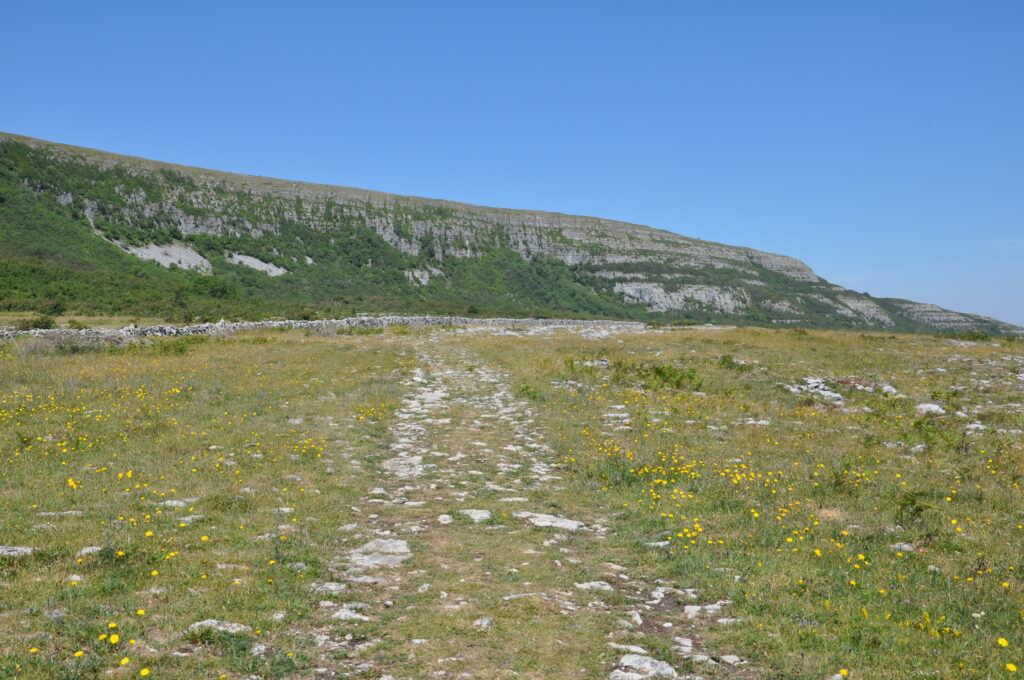
Habitats
Glance at the Burren and you might think it was rock and little else. It is, however, a very complex ecosystem. The habitats within the park grade into one another, creating a mosaic of habitats that are hard to isolate. Limestone pavement is often intermixed with calcareous grassland and hazel scrub, or ash woodland on limestone pavement.
All the major Burren habitats are represented within the park. Around 75% of plant species found in Ireland are represented within the habitats of the Burren, including 23 of Ireland’s 27 native orchid species.
Limestone Pavement
Limestone pavement has become synonymous with the Burren and covers most of the National Park, although usually in a mosaic with other habitats. The pavement may be of either a smooth or shattered type.
Calcareous grassland
Calcareous grassland is found on the terraces of the mountains and between the limestone pavement where there is also a thin layer of soil, as well as on glacial deposits throughout the Burren. These calcareous grasslands host an extraordinary composition of flora. It is these grasslands, found in a mosaic with limestone pavement, which attract botanists from all over the world to study this unique mixture of plants growing together.
Hazel Scrub
Hazel scrub is a common habitat within the Burren and occurs anywhere there is enough soil and shelter. Large tracts of the southern Burren are completely blanketed with hazel scrub, from knee height to 5 metres. The hazel provides shelter for many species of fauna (badgers, pine martens, foxes, red squirrels, mice and shrews), and also for plant and tree species such as blackthorn, hawthorn, brambles, ash, holly and willow.
Deciduous Woodland
Mature deciduous woodland is not common within the park, but there are some excellent examples of ash/hazel woodland, pine forest and oak/ash woodland. Scrub will turn to mature deciduous woodland with time, given adequate depth of soil and shelter. These woodlands tend to be found in dry valleys that have steep sides where the wind sweeps across the top, or in the shelter of cliffs.
Turloughs
The word turlough comes from the Irish word ‘tuar loch’ meaning ‘disappearing lake’. Turloughs are areas that flood in winter or during times of heavy rain. They are fed from groundwater, as opposed to rivers, either through swallow holes or through cracks in the lakebed. The turloughs in the National Park generally have very low nutrient levels and their oligotrophic status means that they are of great botanical interest. Shrubby cinquefoil, a rare and protected species, is one of the plants found in the high flood zone. Also present is the dark moss, Cinclidotis fontinaloides.
Calcareous Fen
In certain areas that are liable to periodic or seasonal flooding, such as the margins of Lough Gealáin and in the townland of Ballyeighter, a calcareous peat has developed. These areas support a rich fen vegetation characterised by species including black bog-rush, purple moor-grass and bogbean, as well as a range of orchid species. While similar wetlands elsewhere in the country have been lost through drainage, the Burren has extensive, intact areas of fen.
Permanent Lakes
There are a number of lakes, both semi-permanent and permanent, within the National Park. Some behave partly as turloughs and are fed from the groundwater through springs and sinkholes on their peripheries. They vary from Lough Bunny to Travaun Lough, which is nearly empty in the summer. The most extensive area of reed swamp occurs in the Ballyeighter Lough area. This forms part of an extensive wetland encompassed in the catchment of the upper Fergus River and is probably the most important oligotrophic calcareous system of freshwater lakes in Western Europe.
Cliffs and Scree
The architecture of the Burren uplands is that of terraces divided by cliffs. The debris that has fallen from these cliffs forms small scree areas. The vegetation on the cliffs is almost identical to that on the limestone pavement areas. However, trees that get a foothold on the cliffs often grow larger than their counterparts on the flat pavement, as grazers cannot reach them. On the southern slopes on Mullaghmór, large yew trees can be seen growing out of what seems to be pure rock.
Flora
The Burren region is internationally famous for its landscape and flora. During the summer months visitors will see a colourful diversity of flowering plants living together within one ecosystem.
Botanically, the Burren is one of the most fascinating regions in Western Europe: plants normally found in widely separate parts of the continent grow alongside each other. For example, mountain avens, a species usually found in sub-arctic and mountainous areas, can be found alongside such southern European species as bloody cranesbill and the dense-flowered orchid, whose distribution is centred around the Mediterranean.
Plants ordinarily associated with acidic conditions, like heathers, also grow abundantly on the Burren limestone, and plants typical of woodland grow in open conditions.
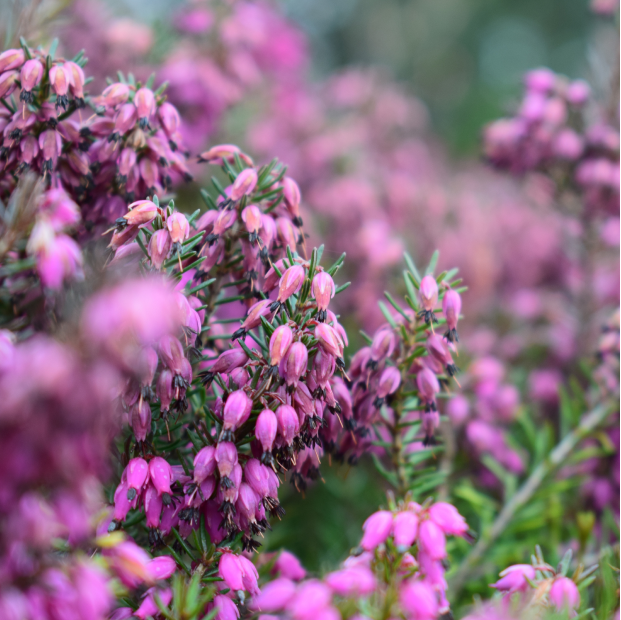
above: Heather
Noteworthy Species
Among the many varied and beautiful flowers which have come to symbolise the Burren are spring gentian, mountain aven, shrubby cinquefoil and bloody cranesbill and, on the higher terraces, the hoary rock rose.
The spring gentian is the smallest of the gentians, typically growing only a few centimetres tall. However, there are few plants that can match the brilliance of its blue petals.
The flowering time of this native perennial is April–June. It grows in open stony calcareous grassland, limestone pavements, fixed dunes, and can be found in the Burren, Co.Clare and Co.Galway.
Sources: Plantlife
This evergreen, perennial, dwarf shrub with long creeping stems is truly one of the treasures of the Burren. ‘Dryas’ from Greek drus or Oak, its little leaves resemble miniature oak leaves and have silvery undersides. Its white flowers (20-40mm ) have eight or more petals – ‘Octopetala’ – and a circle of numerous golden stamens. It flowers from May to July on limestone ledges, cliffs and heaths. Later in the year its seeds are borne on 20-30mm feathery, silvery achenes. Not frequently found throughout Ireland, it was very common throughout Europe over 10,000 years ago as evidence, in the form of pollen grains, shows. Part of what is known as the arctic/alpine element of the Burren flora, it flourishes in the Arctic, the mountains of Europe and is the national emblem of Iceland. It is a very special native and belongs to the family Rosaceae.
Sources: Wildflowers of Ireland
Special plant of the Burren and just a couple of other locations in the west, this deciduous, downy shrub grows around turloughs and other rocky areas which are subject to flooding. It’s small, only reaching 1 metre, with peeling bark, and has bright yellow 5-petalled flowers (2cm across) in clusters, from May to July. These plants are either male or female, the former bearing stamens, the female plants with no stamens. The leaves are grey-green, pinnate with 3 or 5 lanceolate leaflets. Formerly known as Potentilla fruticosa, this is a native plant and it belongs to the family Rosaceae.
Sources: Wildflowers of Ireland
With its most attractive foliage, and its bright red-purple flowers, it carpets rocky places, banks, and even grows in the little hollows in the limestone pavements. From June to August, these 2-3cm five-petalled flowers appear, each on its own hairy stem. The leaves are round but deeply divided, almost to the base, into between five and seven lobes. The fruits, as is common to all cranesbills, end in long pointed beaks or bills which split into five seeds. This outstanding native plant of the Burren belongs to the family Geraniaceae.
Sources: Wildflowers of Ireland
Under the 1999 Flora (Protection) Order, this plant is protected in the Republic of Ireland, which means that the picking, uprooting, sale or possession is prohibited, except under licence. Helianthemum means sunflower, and this small, creeping undershrub carries its racemes of small (10-15mm) golden-yellow crinkly-petalled flowers like small bursts of sunshine from April to July. At the centre of each flower is a crowded cluster of golden stamens. The dark green, opposite leaves are silvery beneath. A native plant, only occurring in Co Clare, this plant is found growing on limestone rocks. It belongs to the family Cistaceae.
Sources: Wildflowers of Ireland
Orchids of the Burren
Orchid species flourish here. In fact, 23 of Ireland’s 27 orchid species can be found in the park. The first to flower each spring are the early purple orchid and the dense-flowered orchid. Other species here include fly orchid, bee orchid, butterfly orchid and four species of helleborine, including the rare sword-leaved helleborine.
In tall spikes (up to 40cm), on neutral or calcareous soil, this stunning orchid can be found from April to June. The colour of the flowers can vary from deep purple, through pink, to white, and the flowers can be distributed in dense or quite loose spikes. The lower leaves first appear in January as a rosette of four to eight oblong, blunt-tipped leaves and can be plain, spotted or heavily blotched. The flower stem arises in spring and along it are small leaf sheaths. A second distinguishing feature is the distinct smell of tom-cat’s pee! Early-purple Orchid grows well in broadleaved woodland, on road verges and on limestone pavement.
This perennial is a native plant and it belongs to the Orchidaceae family.
Sources: Wildflowers of Ireland
While this wildflower is unlikely to win any prizes for being a thing of beauty, it certainly could be called quite a curiosity. It is a self-pollinating orchid with a tightly-packed spike (2–6 cm long) of ten to thirty pale, creamy flowers – sometimes with a pinkish cast. Each of these seem to be almost closed over, with only the lower forked lip protruding from the hood, formed by the sepals and upper petals. The erect stem, which reaches 20 cm, arises from two or three basal, lanceolate and, occasionally, spotted leaves. Smaller leaves hug the stem. Flowering from April to June, this plant is confined to the western half of Ireland where it can be found growing on limestone pavements, dunes and short calcareous grassland.
It is a native plant belonging to the Orchidaceae family.
Sources: Wildflowers of Ireland
The Fly Orchid is one of the small group of Orchids which mimic insects in order to attract visitors. ‘Pollination by pseudocopulation’ is the scientific term for this pretence whereby a plant emits the scent and has the appearance of an insect. By this impersonation, an insect is drawn to the orchid and while trying to mate with the flower, pollen is gathered onto its body to be distributed onto the next orchid. Fly Orchid is quite distinctive with its yellow-green sepals and the long, divided, red-brown lower lip of the flower. These flowers are carried in a loose spike of four to ten with long bracts curving upward behind each flower. Fly Orchid blooms in May and June, it grows on limestone pavement, scrub and dry calcareous soils.
A native plant it belongs to the Orchidaceae family.
Sources: Wildflowers of Ireland
On dry, sandy soil, dunes and limestone pastures, in June and July this is such a delight to find. There is no problem identifying a Bee Orchid from all other orchids – its lovely gold and brown velvety lower lip is patterned to resemble the back end of a visiting bumblebee, this in order to attract a similar insect and thereby assist in pollinating the plant. This perennial orchid grows to about 30-40cm high with an erect stem which is clasped by two oblong, lanceolate leaves. Several other leaves form a basal rosette. The unmistakable flowers are borne in spikes and have three spreading pink sepals, two short green upper petals and a large round lower petal which is deep brown and has gold markings.
This is a native plant and it belongs to the family Orchidaceae.
Sources: Wildflowers of Ireland
Stately and elegant plant of undisturbed pasture, bogland and, usually, calcareous heaths, the Greater Butterfly-orchid grows to a greater height than its little sister, the Lesser Butterfly-orchid. It reaches 50 cm and bears its beautiful creamy-white flowers in a loose, somewhat pyramidal, spike. Each vanilla-scented flower is comprised of two spreading lateral lobes, a long lip which is tinted pale green towards the tip, and the spur. This spur is a nectar-filled tube to attract pollinating moths. The pollen stalks in this flower are arranged, within the flower’s opening, in an inverted V whereas those of the Lesser Butterfly-orchid are parallel to each other.
A perennial plant, it blooms from May to July. This is a native wildflower and it belongs to the Orchidaceae family.
Sources: Wildflowers of Ireland
Also known as Sword-leaved Helleborine, this elegant member of the family Orchidaceae is a slender stemmed plant which bears numerous strap-shaped dark green leaves, the largest at its base. On its slender 25-60 cm high stalk it carries some beautiful pure white 12mm long, bell-shaped flowers, each with a small bract. Through June and July, graceful spikes of 3-20 flowers open, in each is an orange spot at the base of the lip.
This native plant is considered to be rare here and is protected under the 2015 Flora Protection Order in the Republic of Ireland. In the UK it is classed as vulnerable.
Sources: Wildflowers of Ireland
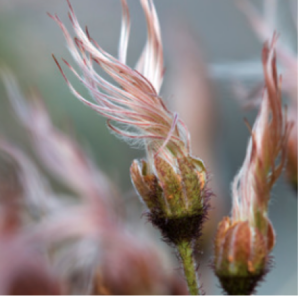
Conservation
Three quarters of the plants found in Ireland are represented in the flora of the Burren. Some of the rarer plants are protected under European Legislation, more under the 1999 Flora Protection Order.
By leaving the plants where you see them, you are helping to protect the ecosystem, and leave it for others to appreciate. Hopefully, if the plants are appreciated in their natural habitat, they will be there for future generations, too.
Fauna
The nature of the terrain and the traditional farming methods employed in the area have left the Burren relatively unspoilt and undeveloped. Except on the deeper glacial till soils, there has been little disturbance or intensified farming, creating undisturbed habitats for wildlife to thrive.
Ninety five species of bird have been recorded within the Burren National Park, at least 50 of which have used the park for breeding. Among the most dramatic of the birds in the park are ravens, peregrine falcons, kestrels, merlin and hen harriers.
There is also a good representation of the smaller birds like finches, tits and warblers. In winter, when the lakes and turloughs are full, there is a healthy population of over-wintering wildfowl like curlew, lapwing and golden plover. Whooper swans and mute swans are also common, the whoopers only arriving for the winter months.
The Burren National Park hosts a wide range of mammals. Most of the mammal life of the park is nocturnal, but hares, foxes, feral goats and pygmy shrews may be encountered during daytime. Stoats may also be seen weaving their way in and out of stone walls in search of prey. Other mammals found in the park are the field mouse, brown rat, bank vole, rabbit, red squirrel, badger, otter and mink. The mink was introduced into the Irish countryside as escapees from fur farms.
Both of Ireland’s reptile species are found in the Burren National Park; the native common or viviparous lizard and the introduced slow worm. The former may be seen on sunny days warming itself on the limestone rock.
The common frog and the smooth newt are both found in the wetland areas of the park.
Eels and three-spined sticklebacks occur in some of the turloughs, perch are known to exist in Lough Gealáin, pike in Lough Bunny and salmon, tench and pike in the Ballyeighter Lough system.
Noteworthy Species
Widespread resident throughout Ireland, especially in upland areas. Ravens are Ireland’s largest breeding songbird, slightly larger than a Buzzard. In all plumages, the body, legs and bill are black. In flight, has long and rather narrow wings, with a distinctive wedge-shaped tail. Soars occasionally and performs aerobatics.
Ravens are usually one of the first species to start breeding in the year (February/March). The nest is a large eyrie on a cliff or in the crown of a tree. Traditionally restricted to upland areas, Ravens are increasingly reported from lowland and even suburban areas.
Sources: Birdwatch Ireland
The peregrine is a bird of prey which nests high in the cliffs above the corrie lakes in the National Park. This falcon is capable of catching pigeons and ducks in flight. It is recorded as the fastest living creature on earth, reaching speeds in excess of 200km an hour as it dives down on its prey. The peregrine falcon very nearly became extinct in Ireland due to insecticides weakening the shells of their eggs, but since the introduction of a ban on the insecticide responsible, peregrines have made a dramatic recovery across the country.
The merlin is a shy and rare bird of prey that nests in forestry adjacent to open heath and bog where it hunts for smaller birds and insects to feed to its young. They are small (the male only slightly bigger than a blackbird) and quite low-flying which means they can be difficult to spot. It’s worth keeping an eye out for them if you’re near forestry during the breeding season (April – June). A sign to look for are ‘kill posts’ where the merlin plucks the feathers from its prey (smaller birds) before taking it back to the nest. Look for prominent hummocks or boulders near forestry that might be used for this.
A species of falcon. A small bird of prey with long, relatively narrow wings and tail. Has a short, hooked bill for eating meat. Usually hovers with a fanned tail when hunting for its prey, when it manages to keep its head stationary despite its rapid wing beats. Male and female birds have different plumages, but both sexes are recognised by their brown back and inner upper wings which contrast with their dark upper outer wings. Confusion with Sparrowhawk is possible but Kestrel has narrower, straighter wings and flies using less gliding in its flight.
A widespread breeder throughout the country. Nests in trees, buildings or in cracks in cliffs. Will use old crows nests. Found in a wide variety of open habitats including coasts, moorland, farmland, wetlands, roadside verges and town parks.
Sources: Birdwatch Ireland
The elusive pine marten has always had a stronghold in the Burren, and in recent years it has made a comeback throughout Ireland. They can sometimes be spotted during the day but are shy creatures and rarely seen.
The marten is still quite rare in Ireland, but the population is recovering and spreading; its traditional strongholds are in the west and south, but the population in the Midlands has significantly increased in recent years. The recovery of the European pine marten has been credited with reducing the population of invasive grey squirrels in Ireland. This in turn allows the red squirrel population to recover.
Sources: Wikipedia
Among the seven species of bats that inhabit the park is the lesser horseshoe bat, a species that is endangered in an international context. This bat is confined in its distribution to the western counties of Mayo, Galway, Clare, Limerick, Kerry and west Cork. The small caves in the park provide hibernation sites for this threatened species.
Although not strictly a wild animal, the feral goat is associated with the Burren and herds descended from escaped domestic goats roam freely throughout the park. On sunny days, they can be seen on the slopes of the Burren hills, while in bad weather they take shelter in the woodlands and hazel scrub.
The common lizard, Ireland’s only native reptile, is viviparous, meaning it not only lays eggs, but also gives birth to live young. Females typically give birth to 2-12 fully developed young and can often be seen sunning themselves on dry stone walls, rocks or logs during the summer months. They occupy a range of habitats, including woodland, marshes, heath, moors and bogs.
Lizards can be eaten by larger predators such as birds of prey (they typically form part of the kestrel’s diet), and stoats and mink will kill them if they can catch them. If caught by the tail, lizards have the ability to shed the lower portion, (which soon grows back) allowing them to escape.
Sources: ENFO Wildlife (PDF)
The slow worm has an elongated round body about 50cm long and a pointed head and no legs. It looks like a small snake but is, in fact, a species of legless lizard. The skin surface consists of smooth, round to hexagonal scales that overlap like roof tiles and are roughly the same shape on the dorsal and ventral surfaces of the body.
Sources: Irish Wildlife Trust Facebook, Wikipedia
Butterflies & Moths
The Burren National Park is rich in butterfly species; in fact, the area around Mullaghmore is considered to be the richest butterfly site in Ireland. Twenty-seven of Ireland’s 33 resident and regular migrant butterflies have been recorded here. Five are considered to be endangered or vulnerable and a further four are considered to be near threatened.
Brown Hairstreak
Thecla betulae
Transparent Burnet Moth
Zygaena purpuralis
Pearl Bordered Fritillary
Boloria euphrosyne
Management of the Park’s Habitats
The Burren National Park is managed primarily for nature conservation. The park is unique among the Irish national parks as it is a managed landscape, and the unique flora and fauna rely on farming and ongoing maintenance.
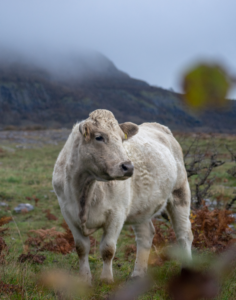
The park comprises a mosaic of important habitats, and the conservation aim is to maintain and enhance these habitats. In order to achieve this, a diverse range of management techniques are employed: from grazing to mechanical intervention. In some cases the key is to have no intervention. Scree slopes and cliffs, for example, are loose rocky habitats which are left alone.
The majority of the park is covered by a mosaic of limestone pavement, calcareous grassland and ash/hazel woodland, with occasional neutral meadows as well as turloughs, springs, fens and lakes.
A number of walking trails are marked within the National Park. The trails are to guide visitors through the park, giving a sense of the unique landscape while aiming to deter footfall in the more sensitive habitats. We manage these trails so they are sustainable and with minimal impact on the environment, both physically and visually.
The limestone pavement, calcareous grassland and woodlands are all managed through grazing by cattle, and in some areas, by horses. The grazing is managed through agreements or licences with local farmers. The majority of these agreements specify grazing in the winter months, so that the grass is short in springtime, allowing a diverse range of species to flower. This practice of putting the cattle on the hills over the winter is referred to as ‘winterage’ or reverse transhumance.
Some of the low-lying areas and turloughs are grazed in the summer time as they are too waterlogged in winter. The meadows are grazed in the winter time and in some cases a late cut of hay is taken off the meadow at the end of the summer. This enables the meadow species to flower and set seed before being removed. The grazing in the winter returns nutrients to the ground through dunging but occasionally a light addition of nutrients is needed to maintain the meadow.
Mechanical intervention is also used, in the form of strimmers, chainsaws and brushcutters. These are used to control the hazel and scrub that is encroaching onto the species-rich grasslands.
The farming community has had an enormous influence on the region: farmers and their land management techniques have managed to preserve and enhance the unusual flora and habitats in the region.
The Burren covers 1% of the land surface of Ireland and is approximately 350 km² in size. Most of the Burren is designated a Special Area of Conservation to protect its extremely unusual habitat.








